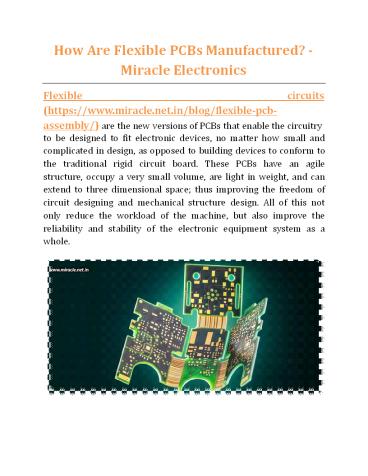How Are Flexible PCBs Manufactured - Miracle Electronics - PowerPoint PPT Presentation
Title:
How Are Flexible PCBs Manufactured - Miracle Electronics
Description:
You must partner with experts offering versatile PCB assembly services from India, such that you can have rigid PCBs built for your normal applications, along with flexible PCBs when necessary, without having to go elsewhere. – PowerPoint PPT presentation
Number of Views:37
Title: How Are Flexible PCBs Manufactured - Miracle Electronics
1
How Are Flexible PCBs Manufactured? - Miracle
Electronics
Flexible circuits (https//www.miracle.net.in/blog
/flexible-pcb- assembly/) are the new versions of
PCBs that enable the circuitry to be designed to
fit electronic devices, no matter how small and
complicated in design, as opposed to building
devices to conform to the traditional rigid
circuit board. These PCBs have an agile
structure, occupy a very small volume, are light
in weight, and can extend to three dimensional
space thus improving the freedom of circuit
designing and mechanical structure design. All of
this not only reduce the workload of the
machine, but also improve the reliability and
stability of the electronic equipment system as a
whole.
2
Flexible PCBs and rigid PCBs The
similarities Both rigid and flexible boards use
almost similar materials, manufactured in the
most similar ways, but in a way that allows the
board to conform to a desired shape, while
flexing during its use. An alternative approach
is to use various etching techniques to thin
down the traditional silicon substrate to few
tens of micrometers, to gain reasonable
flexibility. Let us take a look at some of the
similarities in the manufacturing process.
Firstly, the flexible circuit board material is
chosen, drilled, plated, photo-imaged, and
imprinted just like normal rigid boards. Then,
the panels are baked to remove any moisture from
the wet process. Now, this is where rigid and
flexible PCBs begin to differ. Traditional rigid
PCBs go to the fuse mask station, while flexible
circuits go to the cover lay station. This cover
lay is a lamination process that summarizes and
protects any peripheral circuitry of the
flexible circuit, serving the same function that
the solder mask does for a rigid PCB, but with
an added component of flexibility. The thickness
of the cover lay is prepared of 1 mil thick
polyimide and a 1 mil thick adhesive, which are
laminated using force and heat. The heat allows
for flow of adhesive to fill in any gaps among
the traces and pads to stop the trapping of air
between layers. Manufacturing of flexible
PCBs There are two types of flexible PCBs that
can be manufactured, depending upon the
application they need to be used in single
3
sided and double sided (https//www.miracle.net.i
n/blog/single-layered-pcb- multi-layered-pcb-one-
choose/). Single sided PCBs The processes
involved in manufacturing single sided flexible
PCBs include cutting, drilling, dry film
lamination, positioning, exposure, developing,
etching, removal of dry film, surface finishing,
coverlay lamination, curing, surface finishing,
immersion gold, silkscreening, and
V-cutting/scoring. Double sided PCBs The
processes involved in manufacturing double sided
flexible PCBs include cutting, drilling, plating
through holes, electroless plating, pretreating,
dry film lamination, positioning, exposure,
developing, pattern plating, removal of dry
film, lamination, positioning and exposure,
developing, etching, surface finishing, coverlay
lamination, curing, immersion gold,
silkscreening, and V-cutting/scoring. Why not
make all PCBs flexible? With the benefits that
you learnt about flexible PCBs in this blog,
youll wonder why all the PCBs made today are not
made flexible. If flexible PCBs are so
advantageous, why not have them to replace all
rigid PCBs? This is so because it isn't
practical. Flexible PCBs, because of the
advantages they offer, are much more expensive
than traditional rigid PCBs, which makes rigid
PCBs easier and cheaper to manufacture in a
typical automated high volume fabricating
facility.
4
Thus, it is always advisable to use flexible PCBs
only where necessary, while employing rigid PCBs
where possible, in order to keep the
manufacturing costs down. However, whatever
your requirement may be for PCBs, you need not
go anywhere else. Just get in touch with Miracle
Electronics, where you can get the most reliable
and most versatile PCB assembly services from
India, with end-to-end turnkey solutions
(https//www.miracle.net.in/blog/turnkey-
pcb-assembly-challenging-yet-beneficial/),
blending
together resourceful EMS capabilities of product
designing, system designing, system
architecture, value engineering, manufacturing,
and logistics. For more Information
https//www.miracle.net.in/































